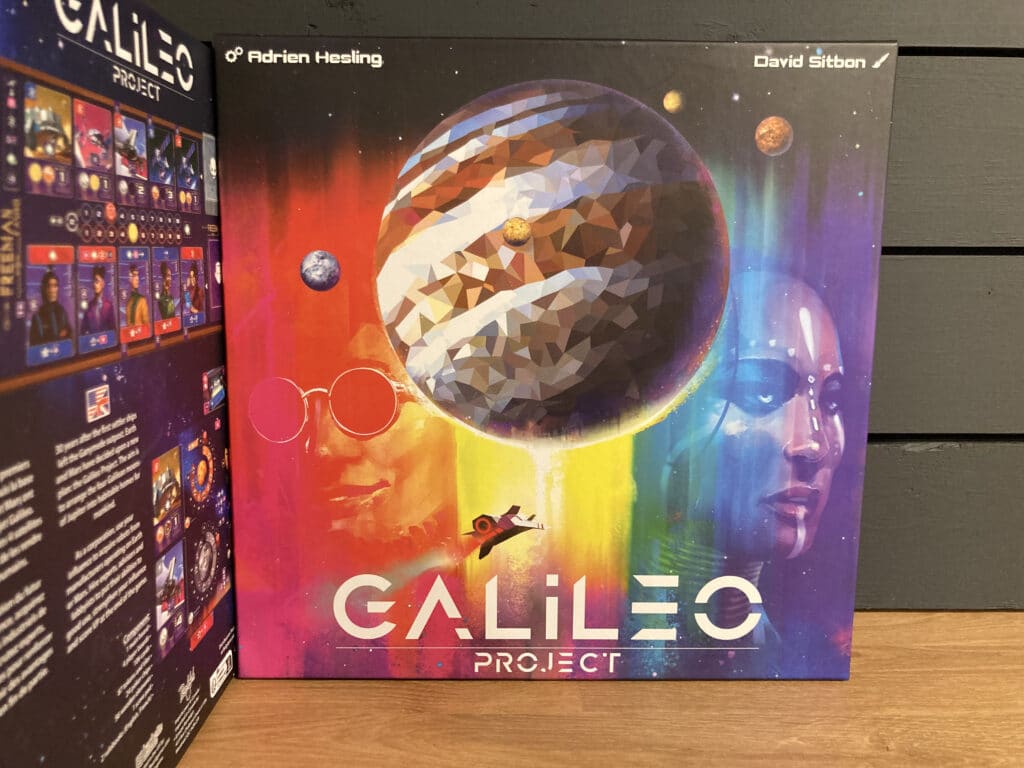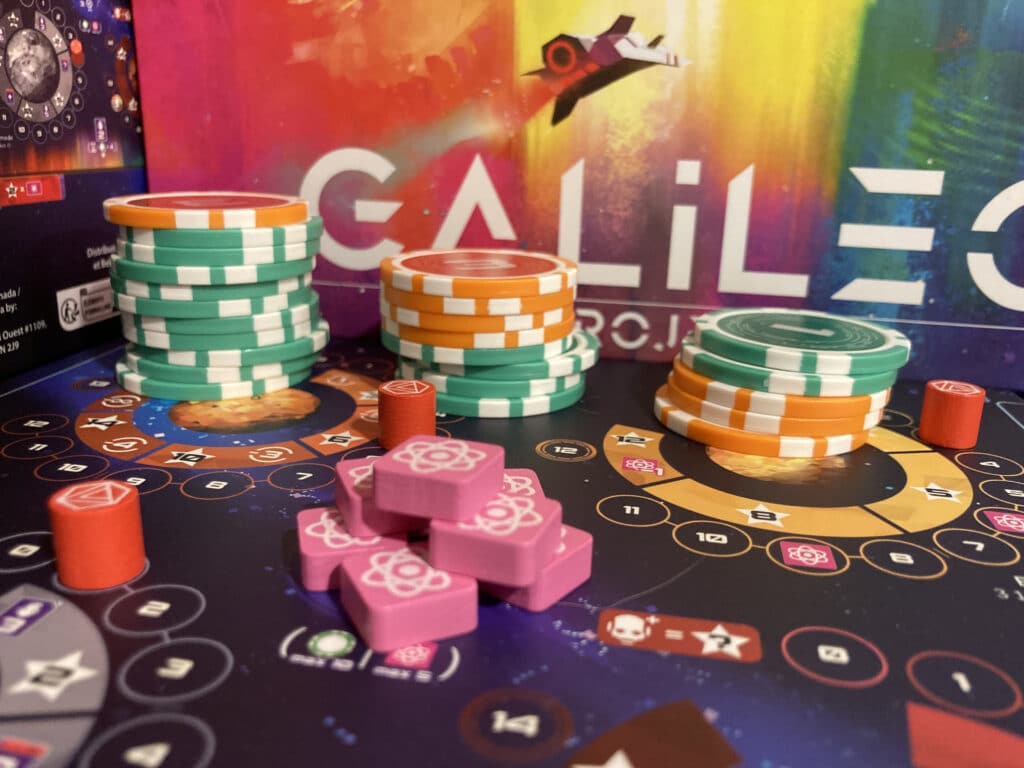Board games make us go to space a lot. Mars. Venus. The Moon. Galileo Project, a board game published by Sorry We Are French, takes us to Jupiter this time, requiring us to make the four satellites of the Jovian planet habitable.
Naturally, we do this by earning Megacredits at the Freeman Casino inside an abandoned satellite. Because it only makes sense!
Over the course of the game, you’ll be recruiting characters and robots using your ever-changing influence in order to bring your wonderful vision of Jupiter’s satellites to life. Of course, other corporations are trying to do the same, so it’ll take some careful planning and risk-taking to take control of humanity’s latest expansion.
So grab a raincoat as we head to the satellites surrounding the planet with the Great Red Spot in Galileo Project!
Galileo Project Gameplay
Galileo Project centers around the Influence track. You can either be on the Red side or the Blue side of this track, which determines which robots you can acquire and which effects your characters will perform when you hire them. Typically, you’ll go up the track when hiring a Character, and you’ll go down the track when acquiring a robot.
During your turn, you can do one of three things:
- Acquire a Robot
- Hire a Character
- Develop a Technology
Robots are sent to one of the four satellites of Jupiter, which will increase the Development track there. In turn, increasing your position on each of these tracks will grant various boons and benefits. For example, Io will allow you to pay 2 Megacredits when acquiring a robot to get an increasing Influence discount the higher up the track you are. However, you can only acquire robots that match the color of the side of the Influence track you are on.
Hiring a Character usually gives you a hiring bonus immediately, and then either an instantaneous effect or an end-game effect depending on your current side of the Influence track. Since this is the primary way to move up the track, you want to be sure that you’re on the best side to make your turn have the most impact. You can always pay 1 Megacredit at the beginning of your turn to switch your side.
Lastly, you can spend Energy (and possibly Megacredits) to develop a Technology. These are powerful effects that might give you extra Megacredits when you would earn one, upgrade a robot to the highest level, or give you a free robot, among other things.
There are also Goals that you can work towards for extra points, earning more for being the first to complete each one. At the end of the game, points are added up across Development tracks, Characters with end-game bonuses, Goals, and Technologies. But you need to be able to pay your Characters 1 Megacredit each, so make sure you plan ahead!
Staking Our C.L.A.I.M. on Galileo Project!
![Galileo Project Icon]() Components
Components
When I opened the Galileo Project box, I was immediately impressed by the component quality. Everything here is top-tier, with a lot of screen-printed wooden pawns and tokens that will hold up to constant manipulation as you move up the Influence and Development tracks. The screen-printing makes each color feel like its own corporation, considering that all of the player boards are identical.
Also, actual clay poker chips! If there is one single component that I love above all others, it is a clay poker chip. The satisfying clinking sound of them being stacked instantly takes me to my happy place. It’s a massive improvement over plastic chips or even wooden currency.
Perhaps the only thing that could have made the components better would be double-layered player boards for the Development tracks in particular, but the expense of that honestly isn’t really worth it in this case. You always have a record of where your track should be, based on your robotic level for that satellite, so if your token gets bumped there’s no love lost.
![Galileo Project Icon]() Luck
Luck
I don’t think that I have the strategy for Galileo Project totally figured out yet. Early Technologies can be strong, but you’re also going to be forgoing your other Developments early to do so. I do appreciate how each satellite has its own focus, pointing you in a strategical direction. This is very helpful for your first few plays as you learn how everything interacts with each other.
Ganymede seems like a really solid early play, at least to get to the point where you can activate either side of any Characters that you hire. That basically means that you’re only restricted to robots when it comes to what side of the Influence track you’re on, which means that you can save those valuable Megacredits for other things.
Robots with a double-assignment, meaning that they can be assigned to one of two different satellites, also seem to be very powerful. If used correctly, you can gain robotic upgrades and Energy multiple times for the same robotic level investment, merely by swapping your robot to different satellites and back again. There are some Characters that reward such play as well.
All in all, there are a lot of different ways you can add ingredients to your point salad, and generally focusing on a variety seems to be one of the best ways to win.
![Galileo Project Icon]() Aesthetics
Aesthetics
Everything about Galileo Project screams space game, and there are actually a lot of similarities in design choices to one of my other favorite space/robotic games, Wild Space. I especially like the fractured art style for Jupiter’s satellites, which gives a nice minimalist feel and a bit of mystery.
The iconography does take a short time to learn, as it’s not necessarily as intuitive as I’d like. For example, I found myself referencing the Character section of the rulebook frequently as I tried to remember the symbol for moving a double-assignment robot or determining if I had to pay Megacredits for something. It helps to keep that page open for quick scanning, especially if you’ve developed Ganymede, which really opens up the number of decision-trees available to you each turn.
![Galileo Project Icon]() Interest
Interest
Galileo Project is an interesting take on the set collection genre, because you’re drafting some of your end-game points through your Characters. Do you take that instant benefit now? Or should you wait and stash that Character for the end? Each robot that you collect grants benefits depending on how many of that robot type you already have, so it behooves you to focus your strategy somewhat.
The Influence track having two sides gives a thoughtful angle to market ‘drafting’ in that you can see where the other players are on the track to determine if you might be able to risk waiting on taking a specific card until a future turn. It’s a bit of a gamble, but it definitely makes that part of the game more exciting, because other players’ positions really do impact your choices. You don’t always have access to the same cards as everyone else.
It’s a game about clever timing and making the most of the options presented before you. Galileo Project rewards patience, but also risk-taking, in the sense that that game wants you to determine the best time to make your plays in relation to the other players. And it makes me want to go back at the end of the game and see if I could have done things more optimally.




![Galileo Project Icon]() Mood
Mood
The two markets – robots and Characters – are constantly shifting, which is the core player interaction in Galileo Project. You can stall other players’ strategies by drafting cards that they might have wanted to take, or by taking a Character instead of a robot to ensure that they can’t pay the heightened cost to acquire it.
As you’re upgrading your own robots and working on your board, it’s easy to get focused on your little corner of the universe and not see what the rest of the table is doing. But you really must keep your eyes peeled! Even though you can earn a bunch of points through the Development tracks, points from Goals can add up too. It’s always worth it to focus on getting at least one Goal, but two would be even better.
Galileo Project: The Ebb and Flow of Robotics!
Galileo Project is a sleeper hit on my shelf, and that’s because it’s difficult to compare it to other games in set collection genre. The Influence track gives it a unique feeling that I don’t really see replicated elsewhere. But, as we all know, there are a ton of games and I only play a small fraction of them.
Regardless, I’m very happy to award Galileo Project with the Nerds on Earth Seal of Awesomeness Award! Wrapped up in a sci-fi package, Galileo Project delivers through its upgradable robots, clean aesthetic, and dual-sided Influence track. It gives you a ton of things that you can focus on, forcing you to decide which ones are the most important to your game.
You can pick up a copy of Galileo Project from your FLGS, from Amazon, or from Hachette Boardgames directly.
[Disclaimer: Nerds on Earth was provided a copy of Galileo Project from Hachette Boardgames in exchange for an honest review.]





